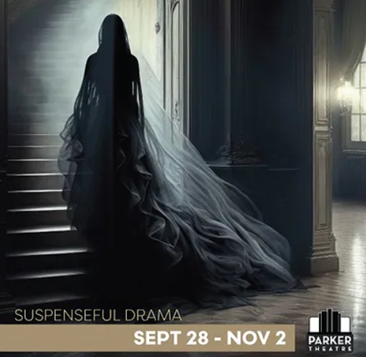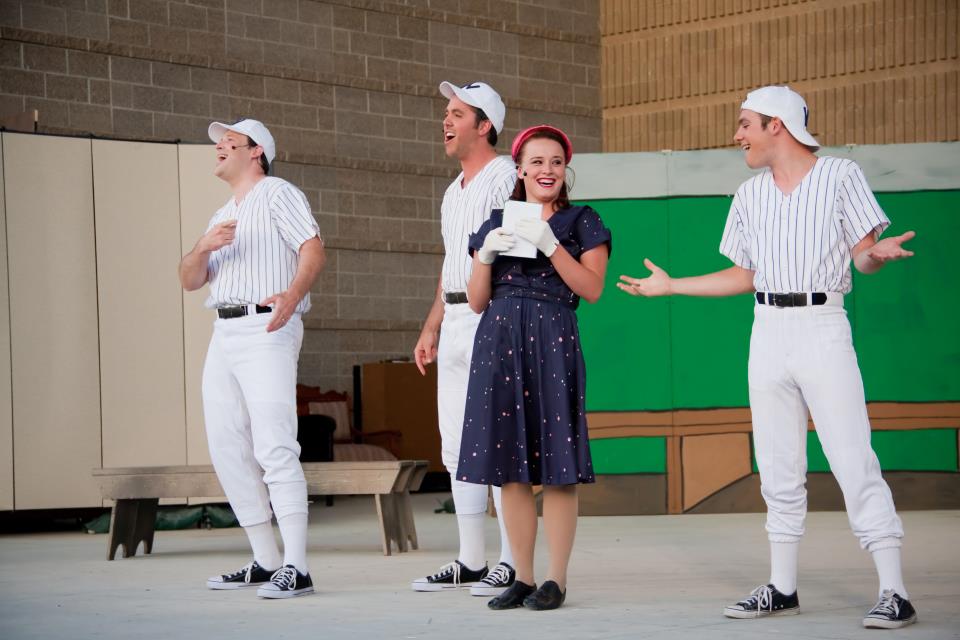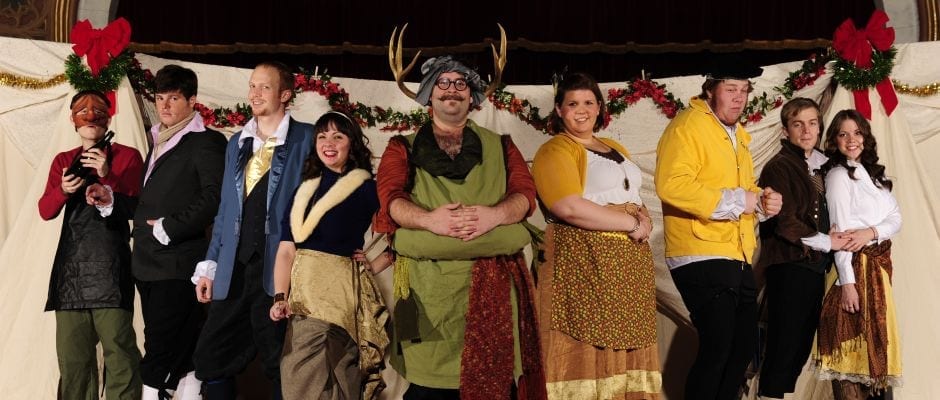SOUTH SALT LAKE CITY — I do not scare easily. I spent years of my youth working in haunted houses and was raised by a man whose love of Stephen King may be unrivaled. Crafting a truly good scare—something more than the kind of “ghost story you tell around the Christmas hearth”—is a craft that requires all elements to work in harmony. Plot, characters, technical effects, and actors must build tension and keep the audience off balance. As director Brinton Wilkins describes in his director’s note, sometimes all that keeps you in a truly terrifying experience with a play is not wanting to look like a “wimp.” Parker Theatre’s production of The Woman in Black by Stephen Mallatratt was a strong production that kept people in their seats—even if only to avoid looking like a wimp.
The production starts as a play within a play. Michael Hohl, known in the program only as “The Actor,” begins on stage laboriously recounting the night of Christmas Eve some years ago as he went to tell a tale he has heretofore been unable to tell. He is interrupted by Lucas Charon, sitting in the house and trying with all his might to teach this pitiful actor how to speak emotively. Hohl’s character tries and fails several times but insists the story must be told, and Charon offers to play the younger version of the central character, Arthur Kipps, while Hohl plays the surrounding parts in his own life’s story.
Each actor was independently strong. Hohl, through the use of clever shifts in physicality, vocal cadence, and on-stage costume changes, played a series of characters. He was dynamic in each role. Each of the men Hohl plays has different horrors in their past, and the various reactions he gives them make them distinct and memorable. In one sequence, Hohl plays a man whose horrors give him respiratory distress, another whose Scottish brogue tremors at the things he’s seen—all while keeping his base character of the older Arthur Kipps distinct from the rest.
Charon, who was strong in Parker’s Of Mice and Men, played a very different character in The Woman in Black to great effect. In this show, Charon plays two different men: the dramatic acting coach who brings levity and grounding to the story, and young Arthur Kipps, who is immersed in the horror of the legendary “Woman in Black” who haunts the manor at Eel Marsh. Charon does an excellent job of letting his character’s personal horror build gradually. He doesn’t escalate to his most maniacal states of terror until the play’s most climactic moments, serving the story well. When the director character feels his deepest emotions, those too are tender and believable. Overall, it was a great performance from the duo—the kind that made me think through my mental rolodex of theatre friends I’d like to play opposite in this show.
Technically, the design was incredible. James Parker did a phenomenal job of using light and shadows to guide the audience’s eye in misdirection and startling terror. Sharp-focused lights, a flashlight in the audience’s eyes, well-placed gobos, and ethereal blacklight all kept the audience rapt in focus. Audible gasps and cries were heard from audience members when spectral sights seemed to appear on stage. The soundscape from Michael Hohl and Spencer Hohl was similarly effective. Sounds would travel through the space like specters floating across the stage. Bloodcurdling screams, supernatural sound waves, and other intense audio experiences heightened the horror. Scenic design, projection, costumes, and other technical elements were equally well executed. In all aspects, the production excelled.
Through the play’s first act, the tension builds magnificently due to strong direction from Wilkins. While the show centers on the two men, it felt at times like there were extra characters within the supernatural elements of the play and the reactions of the two men to them. However, Wilkins broke one of the cardinal rules of horror, and it was to the play’s detriment. At the end of the first act, we see the face of the titular Woman in Black. While her true form must be revealed at some point, it happened far too soon. Where does the play’s terror go from there? From that moment on, there was no more mystery or escalation. A series of technically sound, well-timed jump scares aside, the true horror of the unknown was diminished with every successive appearance of the Woman in Black. The unnamed actress playing the Woman in Black became a bit of a caricature of herself with increasingly gruesome but decreasingly scary manifestations, including some moments that suffered from timing issues as her transitions were a beat too early or too late.
This doesn’t ultimately take away from a fabulous and emotional performance. I had great care and concern for the characters. The mystery unravels well from a strong script that was well-acted and, if possible, even better technically designed. I think this is a solidly PG-13 play where younger or less experienced audience members may leave with less holiday cheer and more of an infusion of the spooky.
I think audiences will love the play, especially if their scare index is in the middle range. If you want to be spine-tingled but not nightmare-fueled, I cannot recommend the play more. However, I have just two requests. First, please don’t aggressively clap between scene changes. That’s a great choice in a musical or comedy, but the tension was cut again and again as someone—I assume a friend or family member of the cast—clapped aggressively and early at every opportunity in the intimate theatre. Second, I noticed in one of the texture gobos across the front that there appeared to be a woman’s face in the light near where the transparent curtain creases. If you see it too, do let me know, won’t you? I’d hate to be the only one to have seen such a grim sight.

These reviews are made possible by a grant from the Salt Lake County Zoo, Arts, and Parks program.





